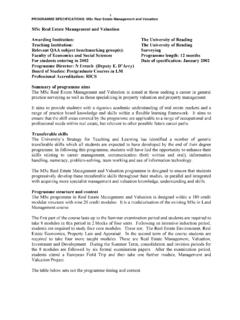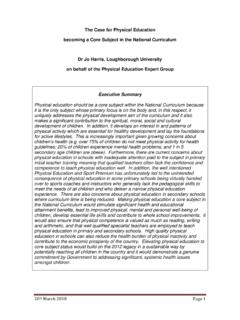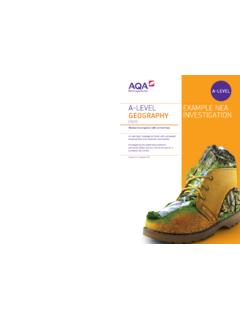Transcription of Geography and Environmental Science - University of Reading
1 Sustainable Livelihood Approach: A critical analysis of theory and practice. Stephen Morse, Nora McNamara and Moses Acholo Geographical paper No. 189 1 Sustainable Livelihood Approach: A critical analysis of theory and practice. Geographical paper No. 189 Stephen Morse Department of Geography , University of Reading , UK Nora McNamara and Moses Acholo Diocesan Development Services (DDS), Idah, Kogi State, Nigeria November 2009 Series Editor: 2 Contents Section Page number 1. Introduction 4 2. The SLA context; two villages in Nigeria.
2 16 3. The SLA space 18 4. Practice of SLA 21 5. Human capital: the households 23 6. Natural capital: land and farming 29 7. Natural capital: Trees 37 8. Social capital: Networks 40 9. Physical capital: assets for income generation 44 10. Financial capital: household budgets 52 11. Vulnerability context 56 12. Did SLA succeed? 58 13. Some conclusions 63 14. Acknowledgements 64 15. References 64 3 Abstract Sustainable Livelihood Analysis (SLA) has since the 1990s become the dominant approach to the implementation of development interventions by a number of major international agencies.
3 It is defined in terms of the ability of a social unit to enhance its assets and capabilities in the face of shocks and stresses over time. SLA first seeks to identify the important assets in livelihood, their trends over time and space as well as the nature and impacts of shocks and stresses ( Environmental , economic and social) upon these assets. Following this, and after taking cognisance of the wider context ( political, legal, economic, institutions, infrastructure etc.), interventions are designed to address any vulnerability of enhance livelihoods perhaps by diversification of income streams.
4 Thus SLA could be said to be a practical framework for evidence-based intervention and has much logic resting behind it, especially in a world undergoing rapid change and where resources to support development interventions are inevitably limited. However, putting SLA into practice is not as easy as it may so often appear, and there are many overlaps with the problems long-reported of making policy in general more evidence-based. Surprisingly there are relatively few reported attempts to take a more critical stance as to the feasibility of SLA and its ability to help deliver real change for people in the developing world.
5 This paper critically assesses SLA from the perspective of putting it into practice in one place: the middle belt of Nigeria. This experience is dovetailed into the existing literature on SLA and to a lesser extent evidence-based policy to explore where problems occurred and how they can be addressed. The Nigerian case study is based on the work of a Catholic Church development organisation (Diocesan Development Services; DDS) and its use of SLA to help provide the basis for changes it was planning to an existing intervention, namely micro-credit. The SLA was piggy-backed onto work it was contracted to do for the Department for International Development (DFID) and indeed the planned changes to the micro-credit scheme were also partly to ensure longer-term impact arising out of the DFID project.
6 Thus the context was one where the SLA was to some extent constrained by decisions that had already been taken and the audience was at least in part other aid agencies that DDS was approaching to help support the micro-credit scheme. However, DDS had over 30 years experience of working in the region and a wealth of expertise of engaging in such village-level work. Further advantages were provided by a decision to focus only on two representative villages and to implement the work over a two year period in parallel with its evolution of the micro-credit scheme. Despite these advantages the implementation of SLA posed many problems and issues, and questions need to be asked as to whether the approach really is a feasible basis for intervention or whether it is nothing more than a convenient label.
7 4 1. Introduction The Sustainable Livelihood Approach (SLA) to development intervention has been in vogue since the late 1990s and formed a central concept of the UK s Department for International Development s (DFID) strategy during the early years of the New Labour government in the UK. The call for emphasis on sustainable livelihoods was set out in the 1997 White paper on international development as follows: ..refocus our international development efforts on the elimination of poverty and encouragement of economic growth which benefits the poor. We will do this through support for international sustainable development targets and policies that create sustainable livelihoods for poor people, promote human development and conserve the environment DFID (1997: Summary, page 6).
8 What exactly are these sustainable livelihoods that DFID intends to help create? One definition is provided by Chambers and Conway (1992) some 5 years before the White paper : A livelihood comprises the capabilities, assets (stores, resources, claims and access) and activities required for a means of living; a livelihood is sustainable which can cope with and recover from stress and shocks, maintain or enhance its capabilities and assets, and provide sustainable livelihood opportunities for the next generation; and which contributes net benefits to other livelihoods at the local and global levels and in the short and long-term.
9 Chambers and Conway (1992, page 7). In this definition a number of strands coalesce. On the one hand there is a requirement for livelihood to be able to recover from stress and shocks but also to be able to maintain and enhance capabilities and assets into the future. A central element in this resilience to stress and shocks is the diversification of elements that comprise livelihood . Just prior to publication of the White paper Carney (1998) provides a simpler vision but also one which has resonance with that of Chambers and Conway: A livelihood comprises the capabilities, assets (including both material and social resources) and activities required for a means of living.
10 And, when merged with sustainability A livelihood is sustainable when it can cope with and recover from stresses and shocks and maintain or enhance its capabilities and assets both now and in the future, while not undermining the natural resource base. SLA is an example of the multiple capital approach where sustainability is considered in terms of available capital (natural, human, social, physical and financial) and an examination of the vulnerability context (trends, shocks and stresses) in which these assets exist. An outline of SLA and suggestions for putting it into practice can be found in guidance notes produced by DFID (available at 5 ).

















